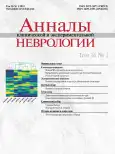Rehabilitation of young children with movement disorders and epilepsy: rational approach and efficacy
- Authors: Bukreeva E.A.1,2, Sednenkova T.A.1,2, Kalyuzhny A.V.2, Osipova G.A.1, Sokolov P.L.1, Sergeenko E.Y.1,2, Chebanenko N.V.3, Laysheva O.A.2,4
-
Affiliations:
- Scientific and Practical Center for Specialized Assistance for Children named after N.V. Voyno-Yasenetsky
- Pirogov Russian National Research Medical University
- Russian Medical Academy of Continuous Professional Education
- Russian Children's Clinical Hospital, Pirogov Russian National Research Medical University Moscow
- Issue: Vol 16, No 1 (2022)
- Pages: 24-31
- Section: Original articles
- URL: https://journals.rcsi.science/2075-5473/article/view/124074
- DOI: https://doi.org/10.54101/ACEN.2022.1.3
- ID: 124074
Cite item
Full Text
Abstract
Introduction. Epilepsy is one of the most common chronic nervous system disorders. Epilepsy in a child requiring physical, psychological and speech therapy significantly reduces its scope and decreases the likelihood of recovery.
The aim of the study was to assess the efficacy and safety of a rehabilitation programme for young children with movement disorders and concomitant epilepsy.
Materials and methods. Simple randomization was used to divide 123 children aged 9–24 months into four groups: three main groups and one comparison group. Patients in group 1 received traditional massage, excluding the cervical region, as their rehabilitation. Patients in group 2 received kinesiotherapy (Vojta therapy) in addition to traditional massage. Children in group 3 participated in a comprehensive programme, including traditional massage and kinesiotherapy (Vojta therapy). Children in the control group did not receive rehabilitation.
Results. A statistically significant improvement in the psychomotor development parameters was observed after a course of medical rehabilitation. It was more significant when the epileptic focus was localized in the right hemisphere or the patient had generalized epilepsy. The outcome was less favourable in multifocal epilepsy and when the epileptic focus was present on the convex surface of the left hemisphere. The third group noted a statistically significant improvement in the GMFCS scores by the end of the comprehensive rehabilitation course. There were no epileptic seizures seen on repeat EEG recordings during the medical rehabilitation and one month after its completion.
Conclusion. A comprehensive approach to planning a course of rehabilitation ensures its efficacy. The location of the epileptic focus and the distribution of epileptic activity along the convex surface of the brain determines the outcome of medical rehabilitation. An increased epileptiform activity index on EEG without signs of clinical deterioration requires more careful patient monitoring but, nevertheless, is not a reason to completely cancel rehabilitation measures.
Keywords
Full Text
##article.viewOnOriginalSite##About the authors
Elena A. Bukreeva
Scientific and Practical Center for Specialized Assistance for Children named after N.V. Voyno-Yasenetsky; Pirogov Russian National Research Medical University
Author for correspondence.
Email: annaly-nevrologii@neurology.ru
ORCID iD: 0000-0001-7660-4933
Head, Department of physiotherapy exercises, assistant, Department of rehabilitation and physiotherapy, Faculty of additional professional education
Russian Federation, Moscow; MoscowTatyana A. Sednenkova
Scientific and Practical Center for Specialized Assistance for Children named after N.V. Voyno-Yasenetsky; Pirogov Russian National Research Medical University
Email: annaly-nevrologii@neurology.ru
ORCID iD: 0000-0001-6089-2045
physician, Department of physiotherapy exercises, assistant, Department of rehabilitation and physiotherapy, Faculty of additional professional education
Russian Federation, Moscow; MoscowAleksander V. Kalyuzhny
Pirogov Russian National Research Medical University
Email: annaly-nevrologii@neurology.ru
ORCID iD: 0000-0002-2222-449X
physiotherapy doctor, Russian Children's Clinical Hospital
Russian Federation, MoscowGayane A. Osipova
Scientific and Practical Center for Specialized Assistance for Children named after N.V. Voyno-Yasenetsky
Email: annaly-nevrologii@neurology.ru
ORCID iD: 0000-0001-6453-0930
neurologist
Russian Federation, MoscowPavel L. Sokolov
Scientific and Practical Center for Specialized Assistance for Children named after N.V. Voyno-Yasenetsky
Email: annaly-nevrologii@neurology.ru
ORCID iD: 0000-0002-0625-1404
D. Sci. (Med.), leading researcher
Russian Federation, MoscowElena Yu. Sergeenko
Scientific and Practical Center for Specialized Assistance for Children named after N.V. Voyno-Yasenetsky; Pirogov Russian National Research Medical University
Email: annaly-nevrologii@neurology.ru
ORCID iD: 0000-0001-7882-1317
D. Sci. (Med.), Prof., main researcher, Scientific department, Dean, Faculty of continuing professional education, Head, Department of rehabilitation and physiotherapy
Russian Federation, Moscow; MoscowNatalya V. Chebanenko
Russian Medical Academy of Continuous Professional Education
Email: annaly-nevrologii@neurology.ru
ORCID iD: 0000-0002-7231-0249
Cand. Sci. (Med.), Associate Professor, Department of pediatric neurology
Russian Federation, MoscowOlga A. Laysheva
Pirogov Russian National Research Medical University; Russian Children's Clinical Hospital, Pirogov Russian National Research Medical University Moscow
Email: annaly-nevrologii@neurology.ru
ORCID iD: 0000-0002-8084-1277
D. Sci. (Med.), Prof., Department of rehabilitation, sports medicine and physical education, Head, Medical Rehabilitation Center, Russian Children's Clinical Hospital
Russian Federation, Moscow; MoscowReferences
- Batysheva T.T., Platonova A.N., Bykova O.V Epileptic syndromes in child-ren with cerebral palsy. Epilepsia i paroksizmalʹnye sostoania. 2011;3(2):10–14. (In Russ.)
- Murtazina T.K. Epilepsy. Modern rehabilitation measures and their impact on the vital activity of sick and disabled people. Thesis dis. ... Cand. Sci. (Med.). St. Petersburg, 2013.
- Batysheva T.T., Platonovа A.N., Bykova O.V. et al. The physical rehabilitation of children with movement disorders associated with epileptic seizures. Detskaya i podrostkovaya reabilitatsiya. 2016;(1):12–16. (In Russ.)
- Sokolov P.L. Cerebral palsy — disontogenesis and rehabilitation. Moscow, 2012. 158 p. (In Russ).
- Kenzhegulova R.B. Rehabilitation problems for children with epilepsy. Kazakh Journal of Physical Medicine & Rehabilitation. 2020;(1):17–24. (In Russ). doi: 10.52889/2708-4167-2021-1-34-23-30.
- Mukhin K.Yu., Petrukhin A.S., Mironov M.B. Epileptic syndromes. Diagnosis and therapy. Reference guide for physicians. Moscow, 2008. 223 p. (In Russ.)
- Accardo P.J., Capute A.J. The capute scales: Cognitive Adaptive Test and Clini- cal Linguistic Auditory Milesetone Scale (Cat/Clams). Baltimore, 2005. 115 p. doi: 10.1177/0883073807300318.
- Capute A.J., Accardo P.J. The infant neurodevelopmental assessment: a clini- cal interpretive manual for CAT-CLAMS in the first two years of life, part 1. Curr Probl Pediatr. 1996;26(7):238–257. doi: 10.1016/s0045-9380(06)80061-7. PMID: 8889388.
- Bykova O.V., Platonova A.N., Balkanskaya S.V., Batysheva T.T. Cerebral palsy and epilepsy — approaches to treatment and rehabilitation. Zh Nevrol Psikhiatr Im S S Korsakova. 2012. (7 Pt 2):64–70. PMID: 23330195. (In Russ.)
- Bukreeva E.A., Ayvazyan S.O., Laisheva O.A. Complex method of therapeutic gymnastics in children at an early age age with epilepsy, accompanied by impaired the function of movement. Detskaya bol’nitsa. 2012;(2):46–51. (In Russ.)
Supplementary files











